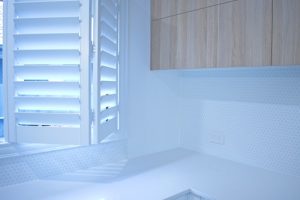Plantation shutters are a popular window treatment choice known for their classic look, versatility, and functionality. They consist of wide louvers (slats) that can be tilted to control light and privacy, making them an attractive and practical addition to any home. However, to maintain their aesthetic appeal and functionality, regular cleaning and maintenance are essential. This comprehensive guide provides detailed instructions and tips for cleaning and maintaining plantation shutters, ensuring they remain in excellent condition for years to come.
Understanding Plantation Shutter Materials
Before diving into the cleaning and maintenance process, it’s important to understand the different materials used in plantation shutters, as each type requires specific care:
- Wooden Shutters: These are made from natural wood, offering a traditional and elegant appearance. They can be stained or painted to match any decor but require careful maintenance to avoid damage from moisture and UV rays.
- Vinyl Shutters: Made from PVC or other synthetic materials, vinyl shutters are durable, moisture-resistant, and easy to clean. They are ideal for high-humidity areas like bathrooms and kitchens.
- Composite Shutters: These are crafted from engineered wood and synthetic materials, combining the look of real wood with enhanced durability and resistance to moisture and temperature fluctuations.
General Cleaning Guidelines
Tools and Supplies
- Soft microfiber cloths
- Feather duster or microfiber duster
- Vacuum cleaner with brush attachment
- Mild dish soap or wood cleaner (for wooden shutters)
- Spray bottle
- Distilled water
- Soft-bristled brush
- Toothbrush (for hard-to-reach areas)
Cleaning Wooden Plantation Shutters
Wooden shutters require gentle cleaning to preserve their finish and prevent damage. Follow these steps:
- Dusting: Use a feather duster or a microfiber duster to remove loose dust and dirt from the louvers and frames. Start from the top and work your way down to avoid redistributing dust onto already-cleaned areas.
- Vacuuming: Attach a brush tool to your vacuum cleaner and gently vacuum the shutters to remove any remaining dust. Be careful not to scratch the wood surface.
- Spot Cleaning: For stubborn dirt or stains, mix a small amount of mild dish soap with distilled water in a spray bottle. Lightly mist the solution onto a microfiber cloth and gently wipe the affected areas. Avoid soaking the wood, as excessive moisture can cause warping or damage the finish.
- Detailed Cleaning: Use a soft-bristled brush or a toothbrush to clean crevices and intricate details on the shutters. Dampen the brush with the soap solution and gently scrub the areas, then wipe with a dry microfiber cloth.
- Drying: Immediately dry the shutters with a clean, dry cloth to prevent moisture damage.
Cleaning Vinyl Plantation Shutters
Vinyl shutters are more durable and moisture-resistant than wooden shutters, making them easier to clean. Here’s how to maintain them:
- Dusting: Use a feather duster or microfiber duster to remove loose dust and debris from the shutters. Work from the top down to ensure thorough cleaning.
- Vacuuming: Use the brush attachment on your vacuum cleaner to remove any remaining dust. This step is especially useful for shutters with larger louvers.
- Wiping Down: Mix a solution of mild dish soap and distilled water in a spray bottle. Spray the solution onto a microfiber cloth and wipe down the shutters, paying special attention to areas with buildup or stains. For tough spots, you can spray the solution directly onto the shutters and let it sit for a few minutes before wiping.
- Detailed Cleaning: Use a soft-bristled brush or toothbrush to clean crevices and tight spaces. Dip the brush in the soap solution and gently scrub, then wipe with a damp cloth.
- Rinsing: Wipe the shutters with a cloth dampened with plain distilled water to remove any soap residue.
- Drying: Finish by drying the shutters with a clean, dry cloth to prevent water spots.
Cleaning Composite Plantation Shutters
Composite shutters combine the best qualities of wood and vinyl, offering durability and an attractive appearance. They are easy to clean and maintain:
- Dusting: Use a feather duster or microfiber duster to remove loose dust from the shutters, starting from the top and working downward.
- Vacuuming: Attach a brush tool to your vacuum cleaner and gently vacuum the shutters to remove any remaining dust and debris.
- Wiping Down: Prepare a solution of mild dish soap and distilled water in a spray bottle. Lightly mist a microfiber cloth with the solution and wipe down the shutters, focusing on areas with buildup or stains.
- Detailed Cleaning: Use a soft-bristled brush or toothbrush to clean crevices and intricate details. Dampen the brush with the soap solution and gently scrub the areas, then wipe with a damp cloth.
- Rinsing: Use a cloth dampened with plain distilled water to remove any soap residue from the shutters.
- Drying: Dry the shutters with a clean, dry cloth to prevent water spots and ensure they remain in good condition.
Special Considerations for Different Rooms
Plantation shutters in different rooms of the house may require specific care due to varying conditions such as humidity, dust, and usage. Here are some tips for maintaining shutters in various areas of the home:
Living Room and Bedrooms
- Regular Dusting: These rooms typically have lower humidity levels, so regular dusting with a feather duster or microfiber cloth is usually sufficient.
- Spot Cleaning: Address any smudges or fingerprints promptly with a damp cloth and mild soap solution.
Kitchen
- Grease Removal: Kitchens can accumulate grease and grime on shutters. Use a mild dish soap solution to wipe down the shutters regularly, especially near cooking areas.
- Regular Maintenance: Clean shutters in the kitchen more frequently to prevent buildup and maintain their appearance.
Bathroom
- Moisture Control: Bathrooms have higher humidity levels, so it’s essential to wipe down shutters with a dry cloth regularly to prevent moisture damage.
- Mildew Prevention: Ensure proper ventilation in the bathroom to reduce the risk of mildew or mold growth on shutters.
Deep Cleaning Plantation Shutters
While regular cleaning keeps plantation shutters looking good, a deep cleaning session once or twice a year helps maintain their pristine condition. Follow these steps for deep cleaning:
- Remove Shutters: If possible, remove the shutters from the window frame for easier access. This step is optional but can make the cleaning process more thorough.
- Vacuum: Use the brush attachment on your vacuum cleaner to remove loose dust and debris from the shutters, paying special attention to louvers and crevices.
- Wash Louvers: Fill a basin with warm water and add a small amount of mild dish soap. Dip a microfiber cloth in the solution and wring it out until damp. Wipe each louver individually, ensuring all surfaces are cleaned.
- Clean Frames: Use the same soap solution and a soft cloth to clean the shutter frames. For intricate details and crevices, use a soft-bristled brush or toothbrush.
- Rinse: Wipe down the shutters with a cloth dampened with plain distilled water to remove any soap residue.
- Dry: Thoroughly dry the shutters with a clean, dry cloth before reinstalling them.

Preventive Maintenance Tips
To keep plantation shutters in excellent condition, consider these preventive maintenance tips:
- Regular Dusting: Dust the shutters weekly to prevent dirt buildup and maintain their appearance.
- Avoid Harsh Chemicals: Never use abrasive cleaners or harsh chemicals on shutters, as they can damage the finish and materials.
- Control Humidity: Use a dehumidifier in rooms with high humidity, such as bathrooms and kitchens, to prevent moisture damage.
- Protect from UV Rays: If shutters are exposed to direct sunlight, consider using window film or curtains to reduce UV damage and fading.
- Lubricate Hardware: Periodically check and lubricate the hinges and other moving parts of the shutters to ensure smooth operation.
- Inspect for Damage: Regularly inspect shutters for any signs of damage, such as cracks or loose louvers, and address issues promptly to prevent further damage.
Repairing Plantation Shutters
Over time, plantation shutters may develop minor issues that require repair. Here are some common problems and how to fix them:
Loose Louvers
- Tighten Screws: Check the screws holding the louvers in place and tighten them with a screwdriver if they are loose.
- Replace Pins: If the louvers are still loose, you may need to replace the pins or tension washers that hold them in place. These parts are available at most hardware stores.
Broken Louvers
- Remove Broken Louver: Carefully remove the broken louver by unscrewing or lifting it from its frame.
- Measure and Cut Replacement: Measure the broken louver and cut a replacement piece from a similar material. Sand the edges for a smooth finish.
- Install Replacement Louver: Insert the new louver into the frame and secure it with screws or pins.
Sticking Shutters
- Check Alignment: Ensure the shutters are properly aligned and not rubbing against the window frame. Adjust the hinges if necessary.
- Lubricate Hinges: Apply a small amount of silicone lubricant to the hinges to ensure smooth operation.
Professional Cleaning and Maintenance
While DIY cleaning and maintenance are effective for most plantation shutters, professional services can provide a deeper clean and address more complex issues. Consider hiring a professional cleaning service once a year or as needed for:
- Thorough Cleaning: Professionals have specialized tools and solutions to clean shutters more thoroughly, removing stubborn dirt and grime.
- Repairs: Professional services can handle more extensive repairs, such as replacing multiple louvers or fixing damaged frames.
- Restoration: If shutters are significantly worn or damaged, professionals can restore them to their original condition, preserving their appearance and functionality.

Conclusion
Plantation shutters are a beautiful and functional addition to any home, but they require regular cleaning and maintenance to stay in top condition. By following the guidelines and tips provided in this comprehensive guide, homeowners can keep their shutters looking great and operating smoothly for years to come. Whether dealing with wooden, vinyl, or composite shutters, proper care ensures they remain a valuable and attractive feature in any room. Regular dusting, gentle cleaning, and preventive maintenance will protect your investment and enhance the overall appeal of your home. For those times when DIY efforts aren’t enough, professional cleaning and repair services can help maintain the shutters’ beauty and functionality.

